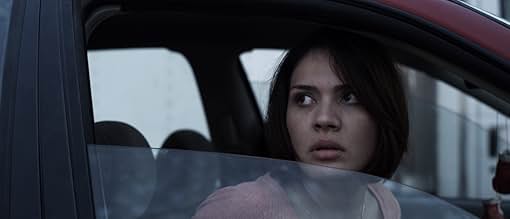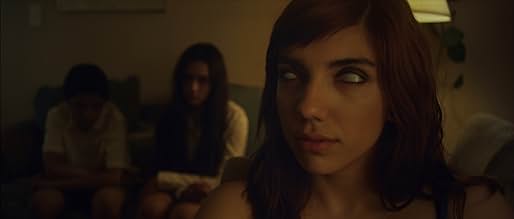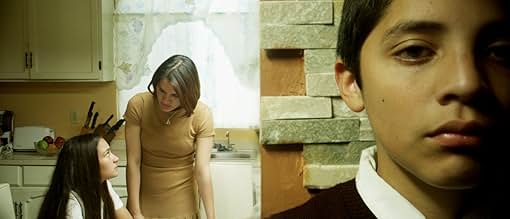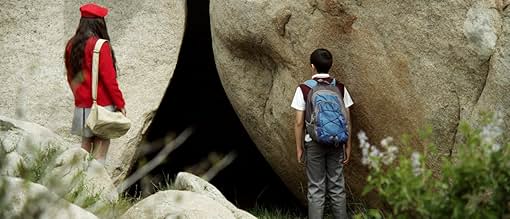AVALIAÇÃO DA IMDb
5,6/10
4,6 mil
SUA AVALIAÇÃO
Um casal perde seus filhos perto de algumas cavernas em Tijuana. As crianças voltam para seus pais no dia seguinte, sem ferimentos. No entanto, algo aconteceu com elas.Um casal perde seus filhos perto de algumas cavernas em Tijuana. As crianças voltam para seus pais no dia seguinte, sem ferimentos. No entanto, algo aconteceu com elas.Um casal perde seus filhos perto de algumas cavernas em Tijuana. As crianças voltam para seus pais no dia seguinte, sem ferimentos. No entanto, algo aconteceu com elas.
- Direção
- Roteirista
- Artistas
- Prêmios
- 6 vitórias e 3 indicações no total
David Arturo Cabezud
- Lucio
- (as David Cabezud)
Enrique Saint-Martin
- Encargado
- (as Enrique Saint Martin)
Julio Granados
- Guardia
- (as Julio Cesar Granados)
Avaliações em destaque
"Here Comes the Devil" by Adrián García Bogliano is a captivating exploration of parental love, supernatural dread, and the fragility of family unity. Set against the sun-drenched yet ominous backdrop of Tijuana, the film begins with the disappearance of two children during a family outing. When they return the next morning, something feels disturbingly different, sparking their parents' investigation into an initial suspicion of abuse-only to uncover something far darker at play.
What sets this film apart is its daring blend of styles and themes. Rooted in the eerie atmospheres of 1970s horror cinema, "Here Comes the Devil" evokes the classics with its grainy visuals, rapid zooms, and low-budget charm. These stylistic choices, while seemingly amateurish at times, contribute to the film's unsettling rhythm, keeping viewers engaged as the story unravels.
Bogliano crafts a layered narrative that juxtaposes familial devotion with themes of possession, loss of innocence, and diabolical influence. The supernatural presence-though never explicitly shown-looms large, manifesting through the children's chilling behavior and the fracturing of their parents' relationship. This subtle approach heightens the tension, proving that psychological and emotional terror can be far more effective than overt scares.
The film's opening scene-a shocking mix of explicit sexuality and brutal violence-sets the tone for a story that refuses to shy away from provocative territory. As the narrative progresses, the mother's increasing belief in a malevolent force contrasts sharply with the father's rational skepticism, creating a compelling dynamic that anchors the escalating horror in relatable human conflict.
The final act shifts focus to familiar horror tropes, including possessed children and supernatural forces, yet it handles them with a fresh sense of dread and ambiguity. The closing moments, deliberately unresolved, leave viewers pondering the pervasive nature of evil and the enduring vulnerability of the human spirit.
It succeeds as an effective horror film that prioritizes atmosphere and emotional resonance over cheap thrills. It is a haunting meditation on parental fear, the loss of innocence, and the darkness that lies just beneath the surface of normalcy.
Although the devil is never explicitly seen, his presence is felt through the actions of the children and the breakdown of the family. The title "Here Comes the Devil" suggests that evil is always present, ready to corrupt.
What sets this film apart is its daring blend of styles and themes. Rooted in the eerie atmospheres of 1970s horror cinema, "Here Comes the Devil" evokes the classics with its grainy visuals, rapid zooms, and low-budget charm. These stylistic choices, while seemingly amateurish at times, contribute to the film's unsettling rhythm, keeping viewers engaged as the story unravels.
Bogliano crafts a layered narrative that juxtaposes familial devotion with themes of possession, loss of innocence, and diabolical influence. The supernatural presence-though never explicitly shown-looms large, manifesting through the children's chilling behavior and the fracturing of their parents' relationship. This subtle approach heightens the tension, proving that psychological and emotional terror can be far more effective than overt scares.
The film's opening scene-a shocking mix of explicit sexuality and brutal violence-sets the tone for a story that refuses to shy away from provocative territory. As the narrative progresses, the mother's increasing belief in a malevolent force contrasts sharply with the father's rational skepticism, creating a compelling dynamic that anchors the escalating horror in relatable human conflict.
The final act shifts focus to familiar horror tropes, including possessed children and supernatural forces, yet it handles them with a fresh sense of dread and ambiguity. The closing moments, deliberately unresolved, leave viewers pondering the pervasive nature of evil and the enduring vulnerability of the human spirit.
It succeeds as an effective horror film that prioritizes atmosphere and emotional resonance over cheap thrills. It is a haunting meditation on parental fear, the loss of innocence, and the darkness that lies just beneath the surface of normalcy.
Although the devil is never explicitly seen, his presence is felt through the actions of the children and the breakdown of the family. The title "Here Comes the Devil" suggests that evil is always present, ready to corrupt.
this movie wont be for everyone. I'm sure im not the only one who has a hard time with sexual horror. There is a lot of uncomfortable sexual scenes in this movie that will make it hard for some people to watch. They even get pretty damn close to crossing the line when it comes to the children yet thankfully they showed some restraint. For such a smutty type movie it did however feel intelligent. The plot was gripping and very intense and had me wondering until the end when it concludes very nicely. I liked the ending a lot and thought it wrapped things up nicely. It also left room for a sequel which would be interesting because of the unique antagonist in this movie. There isn't a lot of gore but when it shows up it was very unnerving and brutal. Here Comes The Devil is a movie that is too raw for a mainstream audience but is smart enough that it will probably find cult appreciation.
Do you remember that horror film made in the 1970's that crossed Picnic at Hanging Rock with The Omen? You know, the one that someone like Jose Larraz or Jorge Grau made back in the day and that used to line VHS stores in a lurid big box?
Here Comes the Devil is a 1970's horror film made in 2012. Although not set in the 1970's, it has the feel of a 1970's horror film. For some reason, I was particularly reminded of Satan's Blood, another Spanish language exploitation movie. This is not a retro homage that winks at the viewer the way Grindhouse or Black Dynamite do. No, Here Comes the Devil is first and foremost an unnerving horror film, one without humor or irony.
The plot has two children exploring a hillside shunned by the locals as their parents take advantage of the time alone to engage in sexual play. Time passes. The children do not come back. Worried, their parents search for them and find nothing. The next day the police find the children safe and sound. All is fine . . . or maybe not. The children are different, withdrawn and having an unhealthy attachment to each other. The parents suspect their children have been sexually abused and go about searching for a suspect. In fact, the truth is much stranger.
Here Comes the Devil is a slow burn. This was more common in 1970's horror cinema than it is now (the original Texas Chain Saw Massacre for instance). Some have found the film slow. However, the film pays off with a genuinely unnerving conclusion and along the way there is an escalating sense of dread. This dread often takes the form of sexual tension, some of it involving the children. This makes the film an unlikely choice for a US remake. It also makes it feel older, from another time period. I had read about Here Comes the Devil in horror magazines like Rue Morgue and Fangoria. I was pleasantly surprised that it lived up to the hype.
Here Comes the Devil is a 1970's horror film made in 2012. Although not set in the 1970's, it has the feel of a 1970's horror film. For some reason, I was particularly reminded of Satan's Blood, another Spanish language exploitation movie. This is not a retro homage that winks at the viewer the way Grindhouse or Black Dynamite do. No, Here Comes the Devil is first and foremost an unnerving horror film, one without humor or irony.
The plot has two children exploring a hillside shunned by the locals as their parents take advantage of the time alone to engage in sexual play. Time passes. The children do not come back. Worried, their parents search for them and find nothing. The next day the police find the children safe and sound. All is fine . . . or maybe not. The children are different, withdrawn and having an unhealthy attachment to each other. The parents suspect their children have been sexually abused and go about searching for a suspect. In fact, the truth is much stranger.
Here Comes the Devil is a slow burn. This was more common in 1970's horror cinema than it is now (the original Texas Chain Saw Massacre for instance). Some have found the film slow. However, the film pays off with a genuinely unnerving conclusion and along the way there is an escalating sense of dread. This dread often takes the form of sexual tension, some of it involving the children. This makes the film an unlikely choice for a US remake. It also makes it feel older, from another time period. I had read about Here Comes the Devil in horror magazines like Rue Morgue and Fangoria. I was pleasantly surprised that it lived up to the hype.
On the way home to Tiajuana, Mom and Dad stop at a rest stop and their two children want to do some exploring in the nearby caves. (No one seems to consider that there are rattlesnakes and mountain lions in this part of Mexico). The children don't come back, and the parents call the police. The police find the children the next morning and return them to the parents. When the children come home, it slowly becomes obvious that something happened to them in the cave.
This movie is about dread, sex and possession, and it takes the audience down a few blind alleys before it gets to the payoff. However, when it does pay off, it is the stuff of nightmares. Creeping sense of "ick" gives way to horror in the last ten minutes.
Finally, most kids love horror movies, especially if there are kids in them. This is NOT a movie for kids.
This movie is about dread, sex and possession, and it takes the audience down a few blind alleys before it gets to the payoff. However, when it does pay off, it is the stuff of nightmares. Creeping sense of "ick" gives way to horror in the last ten minutes.
Finally, most kids love horror movies, especially if there are kids in them. This is NOT a movie for kids.
It only took two of his movies to make me an avid follower of Adrián García Bogliano. He's the type of cinematic artist I deeply respect and even am somewhat jealous of. We're about the same age, but at "barely" 32 years old Bogliano accomplished nearly a dozen of long feature horror films. And although I'm certainly not claiming his movies are bona fide genre masterpieces, they are definitely interesting to explore and – on a more personal note – the type of movies that I'm looking for the most. They are raw, brutal and nihilistic low-budget exploitation efforts that genuinely re-create the atmosphere of horror during the 70's and early 80's. His "Room for Tourists", for example, is one of the cruelest torture-porn flicks out there and especially his "I'll Never Die Alone" is pretty much the only modern day rape & revenge flick that truly lives up to the prototypes of the seventies, such as "I Spit on your Grave" and "Last House on the Left". Evidently I was very eager to catch his newest effort "Here Comes the Devil" when it played at the Brussels' Festival of Fantastic Films, because it allegedly concerns a homage to the devilish cult flicks of the 70's and one giant homage to "Picnic at Hanging Rock". Bogliana again didn't disappoint, although it's different from his previous work and emphasizing more on character depth and disturbing atmosphere. Our director moved up from Argentina to Mexico for this film (I sincerely hope he isn't on his way to Hollywood!) and serves a compelling cocktail of drama, occult thriller and vigilante action. During a family day trip, Felix and Sol's preteen son and daughter request to go on a hiking trip up a hill while their parents "relax" in the car. They don't come back down, though, and the parents spend a long and petrifying night in a nearby motel. But the kids suddenly show up again the next morning, unharmed and just in a minor state of shock, and they all happily return home together. Over the next few days, however, Felix and Sol witness their children behaving increasingly bizarre and asocial. They presume their offspring fell victim to a perverted child molester and promptly seek for vengeance, but in reality something far more disturbing happened to Adolfo and Sara. They seem possessed by dark forces and deliberately head back to the hillside
The slow and sinister pacing, as well as the detailed character drawings, are the main trumps that make "Here Comes the Devil" such a haunting and unsettling thriller. Felix and Sol are very identifiable characters and, especially if you're a parent yourself, you'll mildly cheer for their unlawful (and slightly inconsiderate) decisions. Bogliano masterfully mounts the tension steadily and professionally towards a nearly unbearable climax that is – admittedly – somewhat derivative and vague, but most of all harrowing. Stellar performances from the ensemble cast, gorgeous filming locations and the exact right amount of blood and violence also contribute in making this is a true gem. Please, if you love real horror, leave all the nowadays CGI ghost and zombie crap for what it is and dig into the repertoire of Adrían García Bogliano.
Você sabia?
- CuriosidadesThe credits include a page of Spiritual Help ("Ayuda Espiritual") which lists: Nicolas Roeg, Henry James, Neither the Sea Nor the Sand (1972), director Sergio Martino, Spanish director Eloy de la Iglesia, The Centerfold Girls (1974), David Cronenberg, Donald Cammell, Piquenique na Montanha Misteriosa (1975), O Enigma do Mal (1982), singing group Los Iniciados, horror writer T.E.D. Klein, writer/director Sebastián De Caro, O Colecionador de Almas (1992), William Finley, Marilyn Burns and classic rock station KGB San Diego.
- ConexõesFeatures Devorado Vivo (1976)
- Trilhas sonorasAOK in the USA
Performed by Knife of Simpson (as Knife Of Simpson)
Under license from Nathan E. Perry
Principais escolhas
Faça login para avaliar e ver a lista de recomendações personalizadas
- How long is Here Comes the Devil?Fornecido pela Alexa
Detalhes
- Data de lançamento
- País de origem
- Centrais de atendimento oficiais
- Idioma
- Também conhecido como
- Aí Vem o Diabo
- Locações de filme
- Empresas de produção
- Consulte mais créditos da empresa na IMDbPro
Bilheteria
- Faturamento bruto nos EUA e Canadá
- US$ 4.534
- Fim de semana de estreia nos EUA e Canadá
- US$ 783
- 15 de dez. de 2013
- Faturamento bruto mundial
- US$ 4.534
Contribua para esta página
Sugerir uma alteração ou adicionar conteúdo ausente

Principal brecha
By what name was A Chegada do Diabo (2012) officially released in India in English?
Responda























